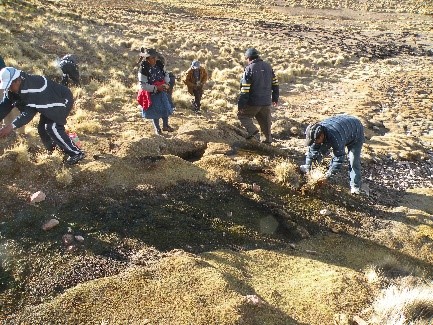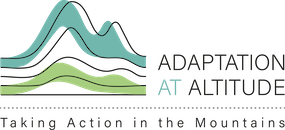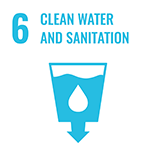Management of vegas and swamps with traditional techniques by the Kolla community of Lagunillas del Farallón, in the Jujuy Puna, Argentina

Summary
In 2012-2013 pilot experiences were carried out on the management of vegas and swamps (high-altitude wetlands) at Lagunillas del Farallón, between 2,900 and 3,500 meters above sea level, in the high Andes of Argentina.
The works were implemented in collaboration with 17 families from this town, under the coordination and support of technicians from the local NGO “Consejo de Organizaciones Aborígenes de Jujuy” (Council of Aboriginal Organizations of Jujuy or COAJ). Dry and eroded sectors of these wetlands were identified, including the evaluation of potential improvement in water distribution. Canalizations and champeo management practices were carried out to improve water distribution in the vegas.
Overview
- Location:
- Implementation sites:
-
- Single country
- Single location
- Mountain region:
-
High Andes / Dry Puna
- Province:
-
- Province of Jujuy
- Site locations:
-
Kolla community of “Lagunillas del Farallón”
- Solution scale:
- Area Covered:
-
- 60km
- Ecosystem type(s):
- Other Ecosystem type(s):
-
- wetlands
- Solution type(s):
- Sector(s):
- Climate impact(s) addressed:
- Other climate impact(s) addressed:
-
- water stress
- Climate impact time-scale(s):
- Main benefit associated with the solution:
- Co-benefit(s) associated with the solution implementation:
- Implementation timeline:
-
- 2012 - 2013
- Sendai targets:
-
Solution details
Main beneficiaries & outcomes
The project benefited 17 cattle families of the Kolla ethnic group (with Quechua influence). Women and men participated in the same proportion. Four elderly people presented their ancient knowledge, with an average of 34 people attending the training and knowledge exchange workshops, including children, adults and the elderly.
Planning and implementation
The “Consejo de Organizaciones Aborígenes de Jujuy” (COAJ) was in charge of the organization of meetings and participatory workshops where the attendees presented their problems and needs regarding the management of vegas and swamps. Furthermore, in field visits the participants showed their proposals for sectors to be managed.
Finance
Coca Cola Foundation -through the +Water initiative of AVINA & Coca Cola alliance-, provided the majority subsidy (approx. 90%), while COAJ co-financed the remaining (10%), through the contribution of local facilities, mobility and personnel. The financing amount was US $ 20,000.
The main indicator was a pilot test achieving the management of 5 ha of vegas and swamps. The program totaled 11 ha at the end of its implementation. In addition to the area managed, the number of participating families was used as an indicator, which greatly exceeded the project expectations.
Innovation
The evaluation of wetland management techniques that had been suspended in the community due to different factors (e.g. depopulation, fragmentation of communal territory in private properties), turned out to be one of the innovative and pioneering aspects in this project. The inspiring participation of the elderly inspiring the young people was an additional benefit. The recovery of the community workforce was another innovative aspect in contrast to the individual efforts that everyone had been making.
Performance evaluation
The main performance indicators were the area managed by the project and the number of people engaged with the project. The AVINA – Coca Cola Alliance was the main compliance evaluator.
Long term project sustainability and maintenance
The community of Lagunillas del Farallón is the main one in charge of the continuity of the project actions. Young people, who valued the traditions and cultural matters are the main actor responsible for the continuity and showcasing the project with other neighboring villages.
Capacities for design and implementation
Knowledge
Cultural practices such as the management of swamps with “champeo” have been lost in some villages. In this case, the community members recognized having stopped these practices for a generation. Out of 20 families consulted, only two of them acknowledged that they continue with management today. In the two families (cattle ranchers per excellence), the older men have been responsible for continuing with the champeos and for transmitting the practices to their descendants. The strategy in this case has been the valuation of traditional knowledge and its complementation with technical knowledge to improve the management of the vegas and swamps. As a result, the young ranchers rediscovered traditional practices that were once practiced by the elderly and that the project made visible again, demonstrating its benefits. In this case, the project contributed to intergenerational transmission.
Technology
Remote sensing and geographical information systems could be valuable tools to support the planning and monitoring of wetlands management, but were not used in this particular project.
Political / Legal
The solution was independent from any government institution/policy.
Institutional
Multi-partner collaboration was a key factor for the success of this pilot experience. The strategic alliance between AVINA and Coca Cola foundations, and with “Consejo de Organizaciones Aborígenes de Jujuy” (COAJ) –a local partner supporting the project implementing on the field-, provided the needed institutional set up, together with a strong alliance with the local communities.
Socio-cultural
A deep comprehension of the social context and the local needs was very important in the project planning and set up. Local communities are a key component of the project. They engaged in co-development and in the implementation of the solution since the beginning.
Outlook & Scalability
Barriers and adverse effects
Non applicable
Transformation and future outlook
The solution promoted by the project will help the local communities and particularly the small production systems to be more resilient to Climate Change, by promoting a more efficient use of water resources and by maintaining healthier wetland ecosystems in the face of the water scarcity scenario.
Potential for upscaling and replication
This project represented a pioneering and inspiring experience for other projects and programs that today are applied both in the Puna of Chile (Corporación de Estudios y Desarrollo Norte Grande) and in the Puna of Argentina and Peru (Wetlands International / Fundación Humedales ).





Comments
There is no content